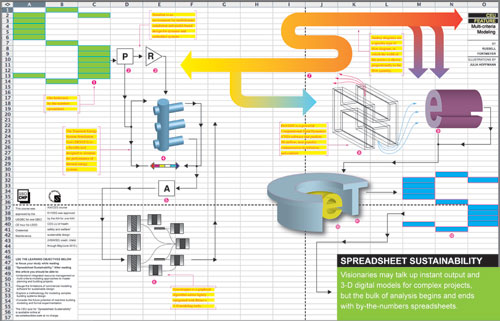Spreadsheet Sustainability
Learning Objectives:
- Understand integrated resource management or multi-criteria modeling approaches to master planning and building projects.
- Gauge the limitations of commercial modeling software for sustainable design.
- Explore a methodology for modeling complex building systems design.
- Consider the future potential of real-time building modeling and formal experimentation.
Credits:
Jim Meacham is one of those engineers who live and breathe spreadsheets. Need to know a building's annual predicted carbon emissions? Ask the spreadsheet. Need to know what happens to a building's water consumption if you switch out cooling towers with a geothermal field? Ask the spreadsheet.
Meacham is a mechanical engineer with Irvine, California-based CTG Energetics, and director of the firm's advanced energy services. He uses spreadsheets almost every day, mostly to support what CTG calls its Sustainable Communities Model, which the firm has developed over years of project work in response to increasingly complex master-planning developments that must balance multiple environmental inputs and outputs as part of a more sophisticated approach to sustainable design.
"There was no tool to analyze green-house gas emissions in an integrated way, where you could look at the tradeoffs between the different design decisions," Meacham says. "It's constantly evolving, since every year we have to update the spreadsheets with the latest emissions factors and industry data."
Ask many engineers and consultants who work like Meacham and they will tell you the same story. The dirty secret of so much sustainable design is that it's not based on fancy three-dimensional building- information modeling of complex inputs and outputs, dynamic parametric analyses, or instant-answer results from super-computers-most of it boils down to someone working out the details of energy, water, transport, and waste systems in an increasingly complicated and proprietary Microsoft Excel spreadsheet. The "what-if" scenarios that are integral to sustainable design are often just cells filled in on an endless parade of tabs and links.
Click on image to see more details |
Illustration by Julia Hoffmann |
This is not to say that the many available and developing software products aren't comprehensive or helpful, but they are often meant to be used at the concept stage of design when details that affect performance and, ultimately, liability for delivering a building aren't as important. Think of Autodesk's Green Building Studio, targeted to early design. Much of the development in complex modeling of sustainability systems-what many call "multi-criteria" modeling or integrated-resource management-has occurred within design firms, like CTG, or in academia.
Spreadsheets and open-source algorithmic software like Grasshopper or proprietary component-based platforms like Simulink/Matlab have allowed individual designers and consultants, driven by project requirements and even personal interests, to invent these new approaches as a way forward for increasingly complicated sustainable projects. While the roots of sustainable design analysis will likely always be in spreadsheets, complex building modeling often occurs in multiple software programs. In turn, these programs are giving way to a glimpse of a future increasingly focused on combining modeling into a single software platform-not a soup, but more of a salad approach. Knowing which approach to apply depends largely on the questions you're asking.










